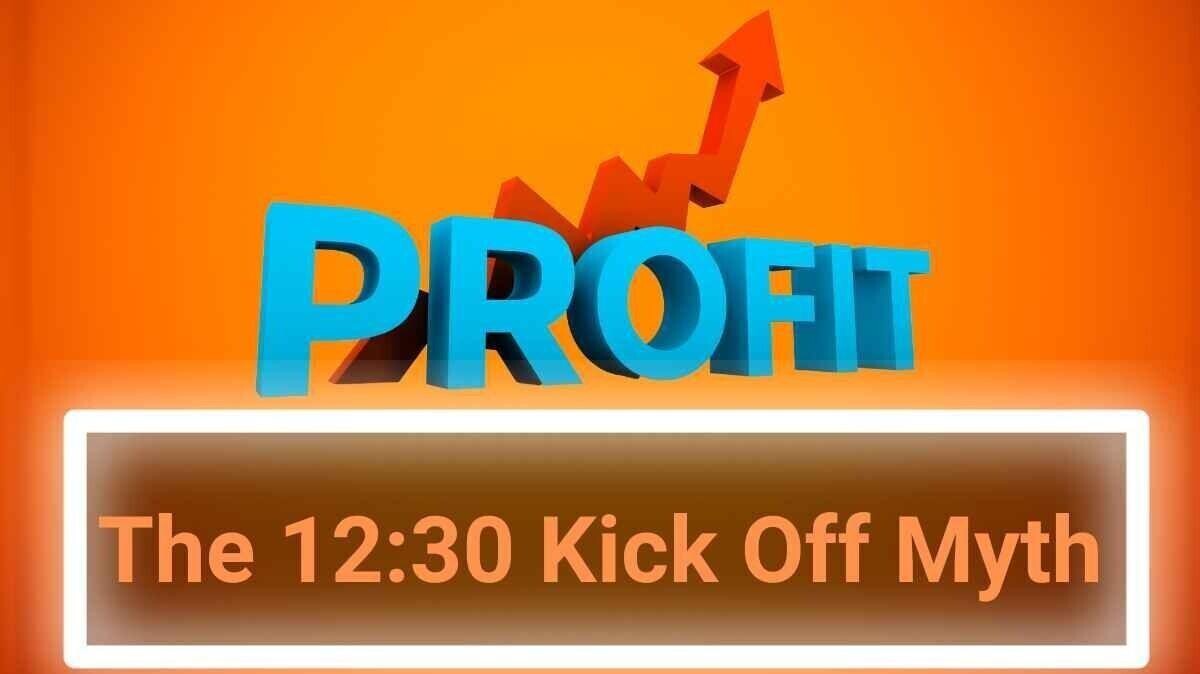
Your data guide to football betting, Dan Tracey shows you where the numbers point before the market catches up.
The 12:30 game in football betting has always been seen as a risky proposition. But is it really as bad as it seems? In this article, we delve into the data to explore the success rate, goals scored, and profitability of this early kick-off. Whether you're considering a standalone bet or part of an accumulator, this information can help you make smarter betting choices. Read on to find out if you should avoid the 12:30 game or not.
🤔 Should you avoid the 12:30 game in football betting?
Should You Avoid The 12:30 Game in Betting?
When it comes to football betting on any given Saturday afternoon, there is always one phrase that is often said “never back the 12:30 game.” A fixture that is viewed as one that leads punters to potential ruin but does the lunchtime offering actually deserve such a bad rap?
In fairness it depends on how you are betting in the first place. If the Premier League’s lunchtime meeting is a standalone wager, then you have every right to roll the dice and see if you come up trumps.
On the other hand, if you are placing an accumulator and waiting for Soccer Saturday to unfold later in the day, the last thing you want to do is see your coupon in the bin before the Soccer Saturday gang have even got to work.

Different strokes for different folks when it comes to the value of the 12:30 game but now we will take another data-driven dive into this particular kick-off and see whether it is a game that should be avoided.
In order to do this, we have gone back to the start of the 2018/19 Premier League season and then also leapt forward into the 2024/25 season – a period of time that has given us a working sample of 168 individual matches.
When looking at these 168 matches, here is what we found:
First, we need to look at whether the favourite came out on top when a game is played at 12:30. If we consider the favourite outcome not occurring as a ‘Jinx’ and the favourite outcome occurring as “No Jinx” this is the split:
| Status | Count | % Split |
|---|---|---|
| JINX | 73 | 43.45% |
| NO JINX | 95 | 56.55% |
| TOTAL | 168 | 100.00% |
As we can see, the favourite outcome got over the line on 93 out of the 168 occasions. This means 56.55% of all matches were true to form and would have meant that punters up and down the country would not have had their fingers burnt.
It may be a majority but at the same time, it must be noted that it is not an overwhelming one. If only because 73 matches, or 43.45% went against the grain. Not quite a 50/50 split but perhaps something to be wary of at the same time.
How often does the Favourite Win the 12:30 Kick Off?
Of course, a home win that is backed by the bookmakers could easily end up as a draw or an away win and a hotly tipped away win could end up as a stalemate or maximum points. With this being a 3-way market, we cannot necessarily treat this as a toss-of-a-coin scenario.
However, what we can do is see whether betting on the 12:30 fixture is a profitable venture and the way we can do this, is by operating with even £1 stakes for each of the 168 matches and always betting on the favourite outcome.
This means if we outlay £168 across a multi-year sample, there is some bad news. News that comes in the shape of £154.99 in return and when we do the maths, we end up with a loss of £13.01 to our names.
| Overall Stake | 168 |
|---|---|
| Overall Winnings | 154.99 |
| Loss | 13.01 |
Before we write off this strategy, there is something that we need to take into consideration, and this is whether you would always bet on the favourite outcome. Because although the shortest price is most likely, it may not offer the right amount of value.
Especially if we see a member of the “big six” go up against another Premier League outfit. The odds would be slanted so far in the direction of the relative giant, that there is arguably no reason to back the favourite at all.

Premier League Average Positions - Who Are The Real Big 6
As we know only 56.55% of 12:30 Premier League matches cannot be considered a jinx and with such a percentage split, this is only likely to generate an overall loss when it comes to an all-favourite betting system.
For such a system to work, you would need the no jinx figure to be approaching somewhere in the region of 75%. Were it to get to this threshold, then there would likely be enough individual wins to then absorb the losses and in turn, give you a greater change of overall profit.
Over/Under 12:30 Kick Offs
Another criticism of the 12:30 kick off is that they are rather dull. A fixture that never springs into life because the players have only just woken up and as a consequence, expectations are never quite lived up to.
But how true is such a statement? The best way to look at this is by looking at the split of games that finished with either over or under 2.5 goals:
| Status | Count | % Split |
|---|---|---|
| OVER | 88 | 52.38% |
| UNDER | 80 | 47.62% |
| TOTAL | 168 | 100.00% |
Interestingly enough, there is the near exact split between our jinx table and this. Of course, the two tables have no real correlation in terms of numbers; this is nothing more than a mere coincidence. 88 matches ended with over 2.5 goals; 80 matches ended with under.
Although if we were to put the two categories in a data matrix, we can begin to see what correlation there may be:
| STATUS | OVER | UNDER |
|---|---|---|
| JINX | 33 | 40 |
| NO JINX | 55 | 40 |
| TOTAL | 88 | 80 |
Here we can see that 33 of the 73 “Jinx” matches ended with over 2.5 goals and 40 ended with under. You are more likely to get a jinx that ends with two or fewer additions to the scoresheet than you are three or more.
However, you are more likely not to find a jinx if the game finishes with at least three goals being scored as opposed to under. 55 of the “Non Jinx” clashes ended with the benchmark being breached, only 40 by comparison did not.

We now have a qualified hunch that total goals will go some way to stopping the 12:30 game from catching you out, but what if we removed the matches that had nothing in the way of “big six” interest.
If we were to do that, our sample is reduced to 134 matches. Does this offer less value when betting £1 on each favourite outcome?
| Overall Stake | 134 |
|---|---|
| Overall Winnings | 120.52 |
| Loss | 13.48 |
Once again, flat betting on the favourite is going to do you few favours. In fact, it is going to lead to you to being nearly as emptier in the pocket. This time, 134 individual bets in isolation would only return £120.52. A loss of £13.48 and highlighting that you cannot simply bet on the shortest price at lunch.
The reason why is because of the percentage split between a game being a “Jinx” or “No Jinx”.
| Status | Count | % Split |
|---|---|---|
| JINX | 56 | 41.79% |
| NO JINX | 78 | 58.21% |
| TOTAL | 134 | 100.00% |
There is slightly more variance this time around. With 134 matches, 78 ended without anything regarding a jinx (58.21%), compared to 56 that ended with a jinx (41.79%). However, taking out the swing games has done little to help any punter’s overall prospects.
Although, we could look at this another way and this is where the hunt for value continues. What about if we looked at the 12:30 games and took out any matches where the favourite was priced at shorter than 1/2?
Could this avoid the pitfalls that come with backing a price that is almost pointlessly short and, in doing so, create an overall profit? First, we will look at how the games look from a favourite performing point of view:
| Status | Count | % Split |
|---|---|---|
| JINX | 58 | 50.00% |
| NO JINX | 58 | 50.00% |
| TOTAL | 116 | 100.00% |
Here we see a perfect split in terms of numbers, the favourite has been caught out on 58 of the 116 matches in this filtered sample, 58 have also got over the line as expected.
Therefore, if we know that the previous splits of matches failed to yield a profit – even when more games were true to form, how does it look in terms of profit and loss?
| Overall Stake | 116 |
|---|---|
| Overall Winnings | 107.36 |
| Loss | 8.64 |
When looking at 116 lunchtime Premier League matches – derived from the 168 match sample and the favourite outcome was at least 1/2 in terms of odds, we can see that individual £1 stakes would yield an overall loss of £8.64.
Again, a system that has fallen short in terms of overall profit but what if we tried one last roll of the dice. What if we were to remove the swing matches that did not involve at least one member of the “big six?” Could that generate profit in any way?
By adding another filter, we are left with a sample of 82 lunchtime Premier League matches that have been played since the beginning of the 2019/20 season. These 82 must have at least one “big six” club playing, and the favourite outcome odds must be at least 1/2.
| Overall Stake | 82 |
|---|---|
| Overall Winnings | 72.89 |
| Loss | 9.11 |
Unfortunately, this filter has not thrown up any joy either. Of the 82 individual £1 stakes that would have been placed, only £72.89 in winnings would have been returned – a subsequent loss of £9.11 to your betting account.
However, there is one way that profit can be found in the long-term at lunchtime and if we take these criteria:
The favourite outcome has to be placed at odds of 1/2 or more
You must back the draw
If you were to add these filters to our original sample, you would be backing the “Jinx” but here are the results:
| Overall Stake | 28 |
|---|---|
| Overall Winnings | 105.58 |
| Profit | 77.58 |
28 individual matches and a total outlay of £28 would return winnings of £105.58. A 277% return on investment. Roughly odds of 4/1 per game when hunting out the picks that go against the tide and now we know this, we can answer the original question.
Should you avoid the 12:30 kick off? No, you should not, but steer clear of short favourites and also go for the draw at the right price.
Current Season
Of course, with the 2024/25 season also now underway, we can take a look at how 12:30 betting has worked since August:
With eight rounds of the Premier League season behind us, a small profit has been generated thanks to six out of the seven results going in the direction of the formbook.
With £20 spent in total on £1 stakes, a return of £22.73 is currently in the season account - a profit of £2.73 or a 13.65% ROI.
| Overall Stake | 20 |
|---|---|
| Overall Winnings | 22.73 |
| Profit | 2.73 |
Editorial Information and Methodology
All Data for this article has been sourced from the very much trusted https://www.football-data.co.uk
All fact-checking and calculations have been undertaken by our Sports Betting Data Scientist, Dan Tracey. Edited and published by Steve Madgwick





